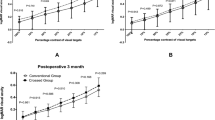Abstract
Purpose
To evaluate the etiology and the clinical outcomes of secondary surgical interventions for dissatisfied patients after pseudophakic monovision.
Setting
Department of Ophthalmology, Kitasato University Hospital, Kanagawa, Japan.
Design
Retrospective case series.
Methods
This study comprised 12 eyes in 12 patients (age 66.2 ± 5.6 years) who underwent photorefractive keratectomy (PRK) enhancement to improve their dissatisfaction after pseudophakic monovision. We quantitatively assessed the visual and refractive outcomes and the subjective satisfaction measured using a visual analog scale, that ranged from 0 (very dissatisfied) to 10 (very satisfied), before and 3 months after PRK enhancement.
Results
Six (50%) of the 12 patients were dissatisfied with their various distance visions because of a large amount of anisometropia (≥2.50 D). Two (16.7%) were dissatisfied with their distance vision after conventional monovision because of residual cylindrical errors (≥0.75 D) in the dominant eye. Three (25%) was an unknown origin. The remaining one of the 12 patients was dissatisfied due to the unadaptability to crossed monovision. Eleven (91.7%) eyes were within ±0.5 D of the targeted correction after PRK enhancement. The overall satisfaction score was significantly improved, from 3.7 ± 2.4 (range 0–7) preoperatively to 6.0 ± 2.4 (range 2–9) postoperatively (p = 0.02). No vision-threatening complications were seen throughout the observation period.
Conclusions
PRK enhancement was effective with predictable refractive results and thus improved patient satisfaction for dissatisfied patients after pseudophakic monovision. These findings also suggest that the accurate correction of refractive errors plays a key role in successful pseudophakic monovision.

Similar content being viewed by others
References
Greenbaum S (2002) Monovision pseudophakia. J Cataract Refract Surg 28(8):1439–1443
Evans BJ (2007) Monovision: a review. Ophthal Physiol Opt 27(5):417–439
Finkelman YM, Ng JQ, Barrett GD (2009) Patient satisfaction and visual function after pseudophakic monovision. J Cataract Refract Surg 35(6):998–1002
Marques FF, Sato RM, Chiacchio BB, Marques DM, Barreiro J, Caetano RL (2009) Evaluation of visual performance and patient satisfaction with pseudophakic monovision technique. Arq Bras Oftalmol 72(2):164–168
Zhang F, Sugar A, Jacobsen G, Collins M (2011) Visual function and patient satisfaction: comparison between bilateral diffractive multifocal intraocular lenses and monovision pseudophakia. J Cataract Refract Surg 37(3):446–453
Handa T, Mukuno K, Uozato H, Niida T, Shoji N, Minei R, Nitta M, Shimizu K (2004) Ocular dominance and patient satisfaction after monovision induced intraocular lens implantation. J Cataract Refract Surg 30(4):769–774
Ito M, Shimizu K, Iida Y, Amano R (2012) Five-year clinical study of patients with pseudophakic monovision. J Cataract Refract Surg 38(8):1440–1445
Ito M, Shimizu K, Niida T, Amano R, Ishikawa H (2014) Binocular function in pseudophakic monovision. J Cataract Refract Surg 40(8):1349–1354
Handa T, Uozato H, Higa R, Nitta M, Kawamorita T, Ishikawa H et al (2006) Quantitative measurement of ocular dominance using binocular rivalry induced by retinometers. J Cataract Refract Surg 32:831–836
Jain S, Ou R, Azar DT (2001) Monovision outcomes in presbyopic individuals after refractive surgery. Ophthalmology 108(8):1430–1433
Kuo IC, O’Brien TP, Broman AT, Ghajarnia M, Jabbur NS (2005) Excimer laser surgery for correction of ametropia after cataract surgery. J Cataract Refract Surg 31(11):2104–2110
Kamiya K, Umeda K, Ando W, Igarashi A, Shimizu K (2011) Clinical outcomes of photoastigmatic refractive keratectomy for the correction of residual refractive errors following cataract surgery. J Refract Surg 27(11):826–831
Kamiya K, Shimizu K, Ohmoto F (2009) Comparison of the change in corneal biomechanical properties after photorefractive keratectomy and lase in situ keratomileusis. Cornea 28(7):765–769
Norouzi H, Rahmati-Kamel M (2003) Laser in situ keratomileusis for correction of induced astigmatism from cataract surgery. J Refract Surg 19(4):416–424
Author information
Authors and Affiliations
Corresponding author
Ethics declarations
Conflict of interest
The author that they have no conflict of interest.
Rights and permissions
About this article
Cite this article
Kato, S., Ito, M., Shimizu, K. et al. Etiology and outcomes of secondary surgical intervention for dissatisfied patients after pseudophakic monovision. Int Ophthalmol 38, 1003–1009 (2018). https://doi.org/10.1007/s10792-017-0551-1
Received:
Accepted:
Published:
Issue Date:
DOI: https://doi.org/10.1007/s10792-017-0551-1




